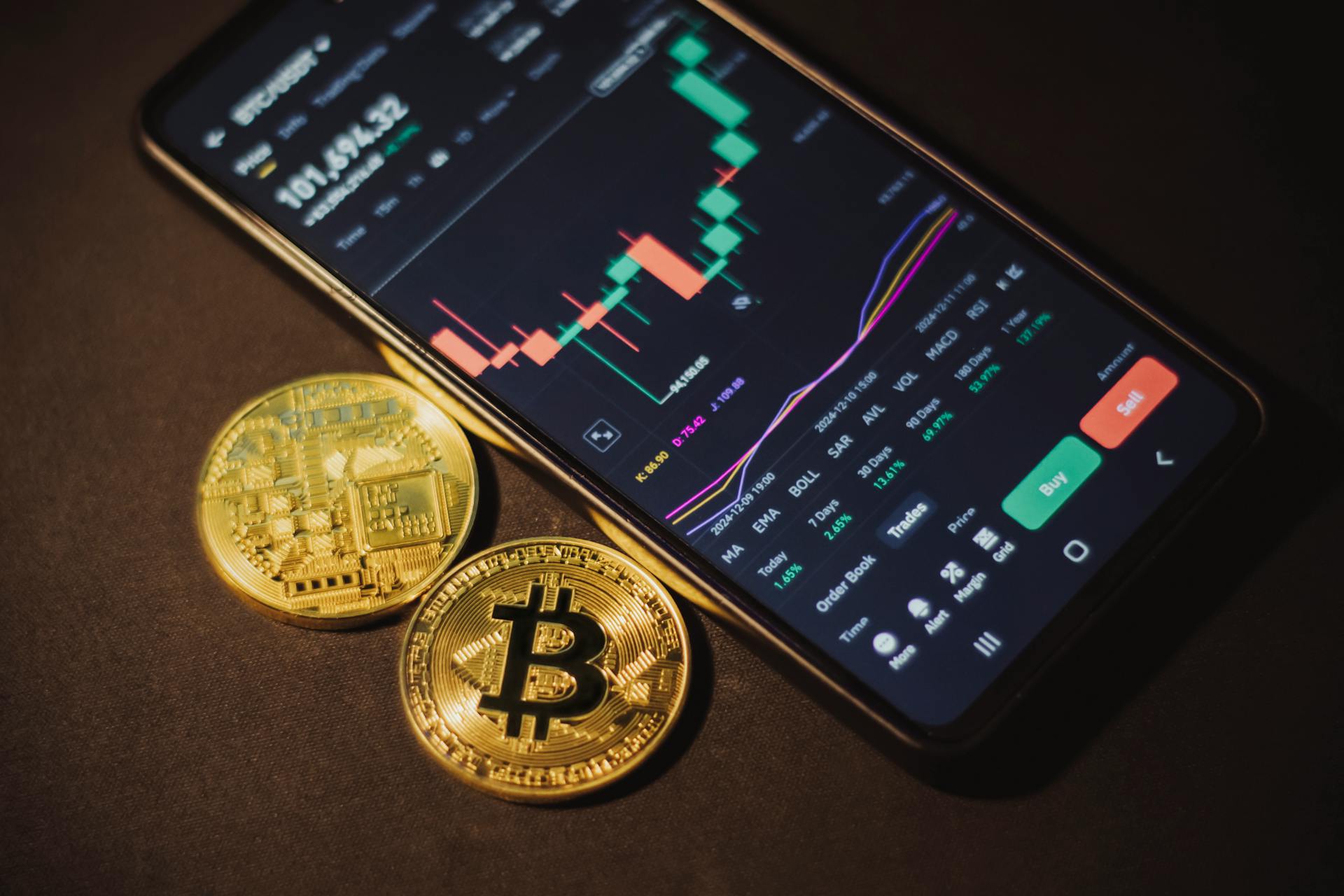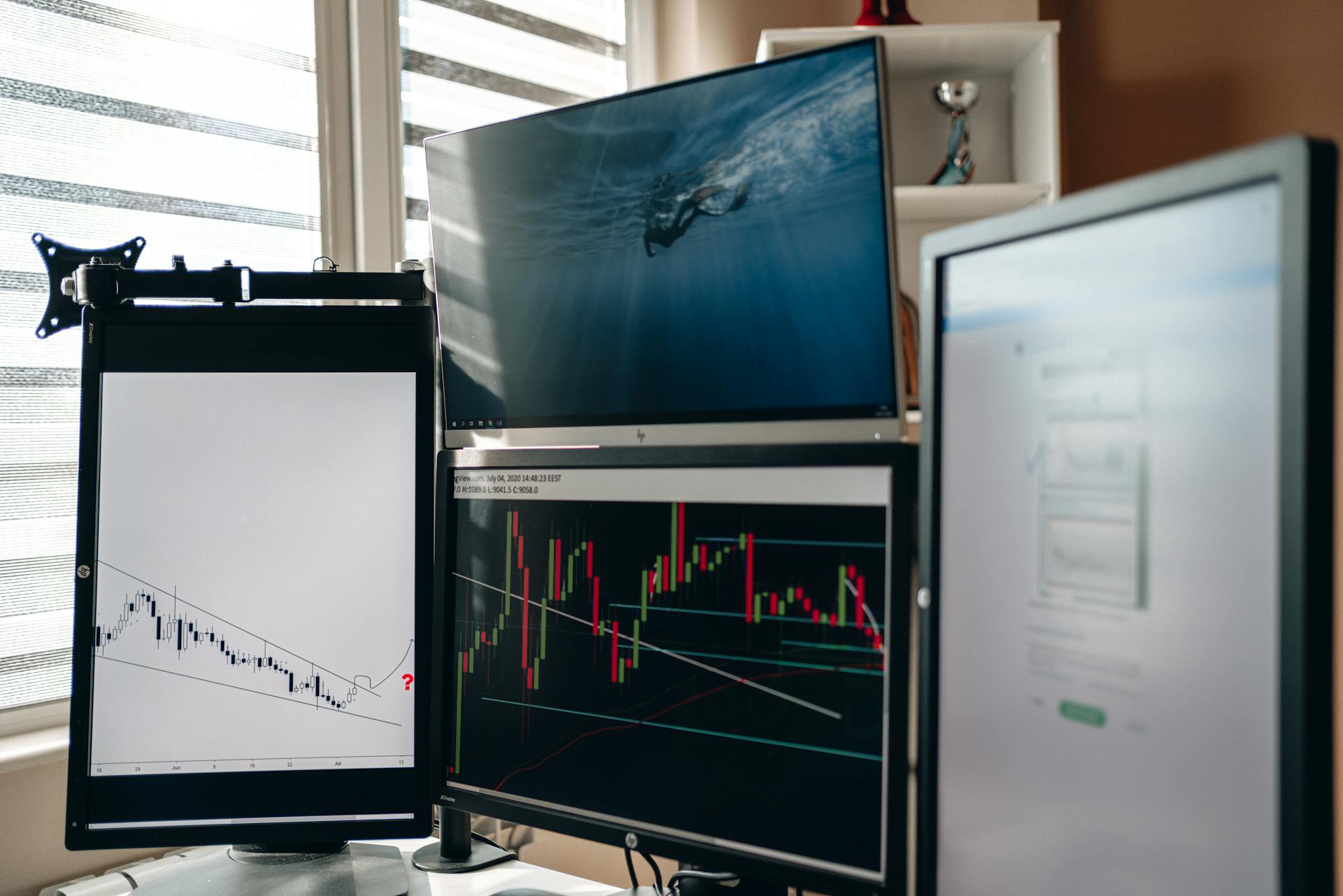
A trading bot, also known as a trading algorithm, is a software program that uses pre-programmed instructions to automatically execute trades in a financial market.
These programs can analyze vast amounts of market data, identify patterns, and make decisions faster and more accurately than humans.
Trading bots can be programmed to execute trades based on a variety of criteria, including technical indicators, news, and even social media sentiment.
By automating the trading process, trading bots can save traders time and reduce emotional decision-making, which can lead to impulsive and costly mistakes.
Trading bots can be used for a variety of trading strategies, including day trading, swing trading, and even long-term investing.
They can also be customized to fit individual trading styles and risk tolerance, making them a valuable tool for traders of all levels of experience.
Related reading: Placing Trades with Trading View from Tradestation
Strategy and Development
A trading bot's strategy is based on a set of rules that interpret market conditions and convert them into tradable choices such as buy, sell, or hold. These rules include position size, entry, exit, and risk management modalities.
To develop a profitable trading bot, you need to find a market edge that is fundamentally solid from an economic and market perspective. This edge should be based on reliable statistical techniques and take advantage of enduring market inefficiencies.
A trading bot's strategy can be developed using any indicator, such as RSI, moving average, or stochastic, as long as it gives you an edge in the market. You can even create a trading bot with price action patterns and market volume.
The key components of a successful trading bot strategy include a strategy with an edge in the market, a well-written trading algo, and a hitch-free execution platform. A poorly written bot would have bugs that cause problems, so it's essential to ensure your algo is robust and reliable.
Here are some key timeframes to consider when developing a trading bot trading strategy:
A trading bot decides when to buy or sell based on preset rules in its code, which are based on a strategy that exploits a possible edge in the market.
AI Advantages
AI trading systems can perform a wide range of activities, including historic price and volume analysis, risk assessment, signal creation, entry and exit suggestions, strategy testing, and trade execution.
By crunching a vast amount of technical and fundamental market data in real-time, AI trading bots can make informed decisions about when to buy and sell various types of financial assets.
Machine Learning enables trading bots to identify, analyze, and draw inferences from data patterns, allowing them to adapt to shifting market conditions and respond to trading opportunities without explicit programmed instructions.
Generative AI can be used to analyze large amounts of unstructured data, such as social media posts, to identify sentiment and other trends that may have an impact on the markets.
The ability of generative AI to process and understand large amounts of data can help traders and trading bots make more informed and profitable decisions.
AlgosOne's automated trading system, which incorporates generative AI with proprietary code, is continually learning and refining its understanding of the factors impacting market conditions.
By utilizing generative AI, AlgosOne's trading system can predict market trends with ever-increasing accuracy, making smart decisions based on real-time data.
How to Develop a Profitable Business
Developing a profitable trading bot requires a solid understanding of the market and a well-designed algorithm. A trading bot is a computer program that can develop and execute buy and sell orders in the financial markets.
To create a profitable trading bot, you need to identify a market edge that is fundamentally solid from an economic and market perspective. This edge should be based on reliable statistical techniques and be able to exploit market inefficiencies.
A good trading bot strategy should have overriding keys to turn it off when the market condition is not suitable for the strategy it is built on, as well as a key to automatically close all positions and stop trading if there is a black swan event that leads to an unusually huge loss.
The key components of a successful trading bot strategy include a strategy with an edge in the market, a well-written trading algo, and a hitch-free execution platform. A trading bot can be based on any technical trading strategy, including mean-reversion, momentum, trend-following, breakout, moving average, RSI, Bollinger Bands, arbitrage, and spread trading strategies.
Some of the factors to consider when selecting a trading bot trading strategy include your trading personality, which influences your trading style, and your personal risk profile, time commitment, and trading capital. A trading bot tends to work best in one specific market condition only, such as a trend-following strategy in a trending market.
The advantages of using a trading bot include no downtime, lack of emotional trading, easy backtesting, and easy trading multiple markets. However, there can be mechanical failures, and you will need to regularly monitor it to ensure functionality.
To develop a profitable trading bot, you should consider the following steps:
- Identify a market edge based on reliable statistical techniques
- Develop a mathematical model that can take advantage of the edge
- Code the bot using a programming language such as Easy Language or MQL4
- Backtest, optimize, and possibly forward-test the bot
- Consider your trading personality and select a strategy that fits your style
Here are some common trading bot strategies:
- Mean-reversion strategy
- Momentum strategy
- Trend-following strategy
- Breakout strategy
- Moving average strategy
- RSI strategy
- Bollinger Bands strategy
- Arbitrage trading strategy
- Spread trading strategy
Remember, a trading bot is only as good as the strategy it is based on, so make sure to choose a strategy with an edge in the market.
Setup Instructions
To set up a trading bot, you can either code one yourself or buy from a bot vendor. Coding one yourself is recommended because it's nearly impossible to buy a reliably profitable bot.
Don't get carried away by the hype on over-optimized bots and trading results - choose to code your bot yourself or hire a coder to code your strategy. Learning coding is not difficult, and anyone can do it.
Setting up your trading bot on your computer means it can only trade when your computer is on and connected to your broker. This requires a stable power supply and internet connection.
Using a VPS through your broker or a third party is a better option, as your bot will run all the time and won't be dependent on your computer being powered on and connected to the internet.
Order Types
You can use market orders, limit orders, and stop orders when trading with a trading bot.
Market and limit orders are the most common types for bot trading, each with its own advantages and disadvantages.
Market orders allow you to get in at the best available market price, but can come with huge slippage, getting you in at a poor price.
Limit orders can help you get in at a better price, but the order may not get filled, and you miss the trade.
Trading very liquid assets can minimize the issue of slippage and commissions.
Backtesting and Performance
To monitor the performance of your trading bot, you can do it manually or create a script to track its performance. You can keep track of the profit and loss column and the number of trades taken to estimate whether the bot is still performing optimally.
To backtest your trading bot strategy, you should do it as often as you need to tweak the strategy or create a new one. It's a good rule to backtest every new strategy before deploying it in the market.
You should use historical data for backtesting, and get as much data as necessary to give you enough sample size for your testing. Divide the data into in-sample data for backtesting and out-of-sample data for optimization and validation.
When analyzing the results of your backtests, you should look at common parameters such as number of trades, profit factor, cumulative returns, annualized returns, maximum drawdown, and Sharpe Ratio.
If this caught your attention, see: Carry Trades
It's recommended to keep your backtested strategies in incubation for at least 12 months before trading live. This allows you to see how the strategy performs over time and make adjustments as needed.
Here are some parameters to look at when analyzing the results of your backtests:
- Number of trades
- How long you are in the market
- Profit factor
- Cumulative returns
- Annualized returns
- Maximum drawdown
- Sharpe Ratio
Forex and Crypto
A forex trading robot is a type of software that assists with foreign exchange trades by analyzing trend signals of price movements in the forex market. These systems can be automated and integrated with online forex brokers or exchange platforms.
Forex robots can also be used to trade cryptocurrency, with some robots designed specifically for that purpose, such as Coinrule, which offers a fully automated crypto trading robot with prices ranging from $0 to nearly $9,000 per year.
Crypto trading bots are automated algorithmic programs that use specific trading strategies based on predefined parameters to execute trades in the global crypto asset markets, and can work 24/7 to compensate for the trader's human limitations.
Here's an interesting read: Currency Trading Robots
Forex Trading Cryptocurrency
Forex trading cryptocurrency is a rapidly growing field, and it's not surprising why. A forex robot can be used to trade cryptocurrency, and one such robot designed for that purpose is Coinrule, a fully automated crypto trading robot that costs anywhere from $0 for a starter subscription to nearly $9,000 per year.
Forex robots can be programmed to trade constantly, 24 hours a day, whenever forex markets are open, but allowing this level of ongoing trading potentially removes the investor from the process. Many investors may prefer to be more active participants in the trading process.
Crypto trading bots, on the other hand, are specifically designed to use specific trading strategies based on predefined parameters to execute trading strategies in the global crypto asset markets. They can work 24/7 in the crypto market to compensate for the trader's human limitation and achieve optimal trades.
Here are some advantages of using crypto trading bots:
- Crypto trading bots offer efficient trading by automating the trading process.
- Crypto trading bots offer round-the-clock trading of the volatile crypto market.
- When set on the right parameters, crypto trading bots have better trading accuracy and market timing.
- Crypto trading bots eliminate human emotions in the trading process and make fewer mistakes if coded well.
In fact, crypto trading bots can eliminate human emotions in the trading process, which can drastically affect outcomes. They are bound to make fewer mistakes if coded well.
Forex Costs
The price of a forex trading robot can vary greatly, depending on the system. Some systems, like the 1000pip Climber System, offer a one-year license for $97 or a lifetime license for $147.
Higher-end options often charge a monthly or yearly subscription price, which can be a significant expense. As someone who's looked into forex trading, I've seen how quickly costs can add up.
The 1000pip Climber System is an example of a system that offers different pricing options. Here are some examples:
It's essential to consider the costs involved in forex trading before getting started. This includes the cost of the trading robot, as well as any other expenses that may arise.
How Crypto Work
Crypto trading bots are automated software that can be bought or subscribed to, and they require some basic understanding of coding and technical analysis to use effectively.
To use these bots, you need to connect them to exchanges using an Application Programming Interface (API), which acts as a bridge between the bot and the exchange platform.
The bot makes trades based on predefined market indicators and parameters, such as price, time frame, and order volume, as well as indicators like moving averages and relative strength index.
You need to choose these parameters carefully, as they determine how the bot monitors the market and makes trade decisions.
The bot executes trades once the market conditions align with your predetermined parameters.
Automated crypto trading bots have direct access to your crypto assets and can make trades on your behalf, so you must restrict your API on what actions bots can take and only use bots you trust.
It's essential to backtest your trading strategy under different market scenarios to increase the chances of it generating a profit in the live markets.
Readers also liked: Ut Bot Indicators for Trading Futures
Cryptohopper
Cryptohopper is a cloud-based automated trading platform that operates on a subscription model with a free 7-day trial. It allows you to set up your trading strategies and use external signals to trade.
Cryptohopper offers a variety of strategies, trading indicators, and candle patterns that can be used to trade multiple cryptocurrencies. This flexibility is a major advantage for traders who want to diversify their portfolios.
You can set up your trading strategies on Cryptohopper and trade multiple cryptocurrencies, making it a great option for those who want to trade a variety of assets.
Frequently Asked Questions
How does a trading bot work?
A trading bot continuously monitors the forex market in real-time, analyzing price changes to execute trades and manage multiple currency pairs automatically. It uses this data to make informed trading decisions, providing a hands-free trading experience.
Is it illegal to have a trading bot?
Having a trading bot is not inherently illegal, but its use is subject to national laws and exchange rules that may limit certain types of trades or practices
Are trading bots a good idea?
Trading bots can be profitable, but only if configured correctly and understood properly. To minimize risks, test or research them thoroughly before investing.
Featured Images: pexels.com


